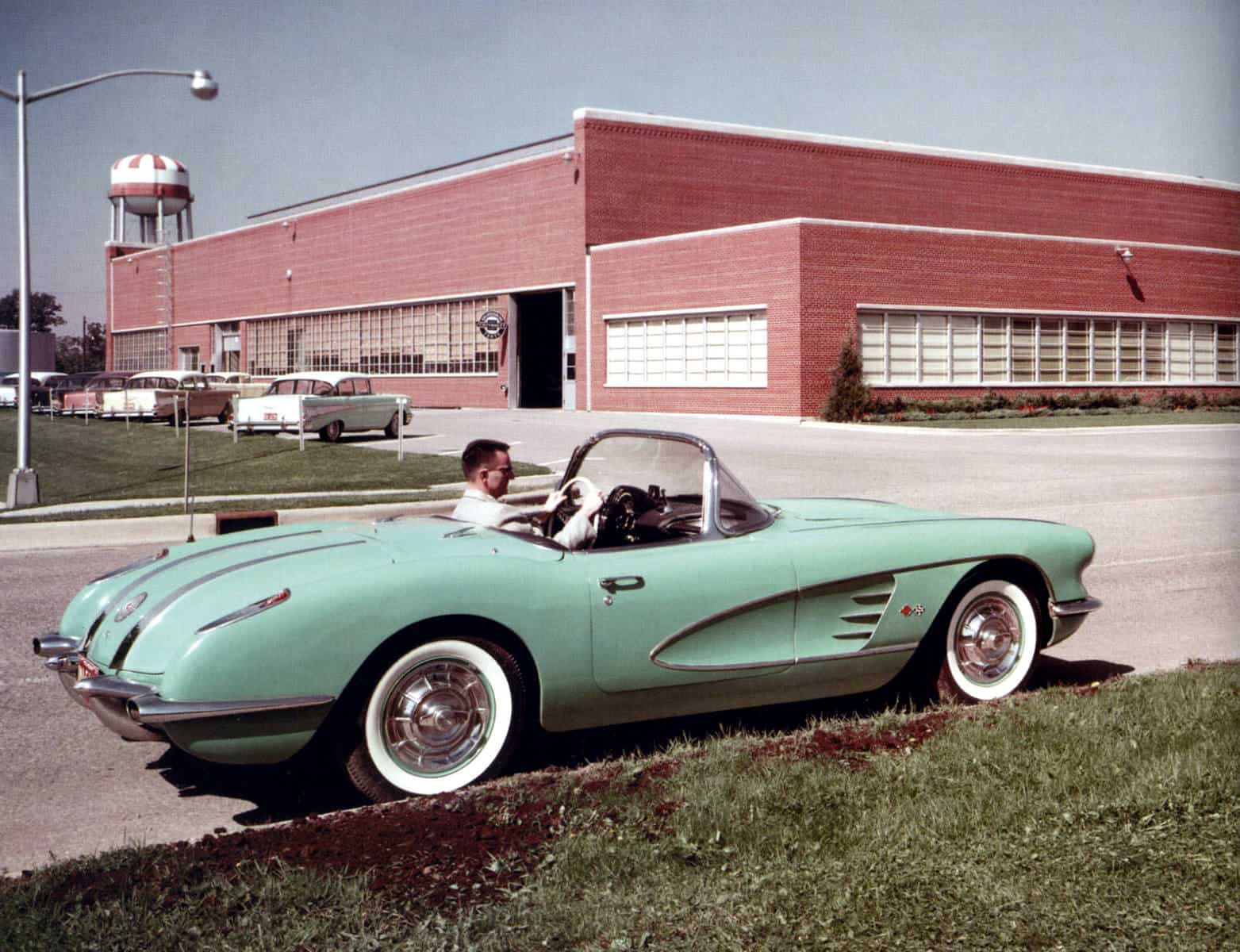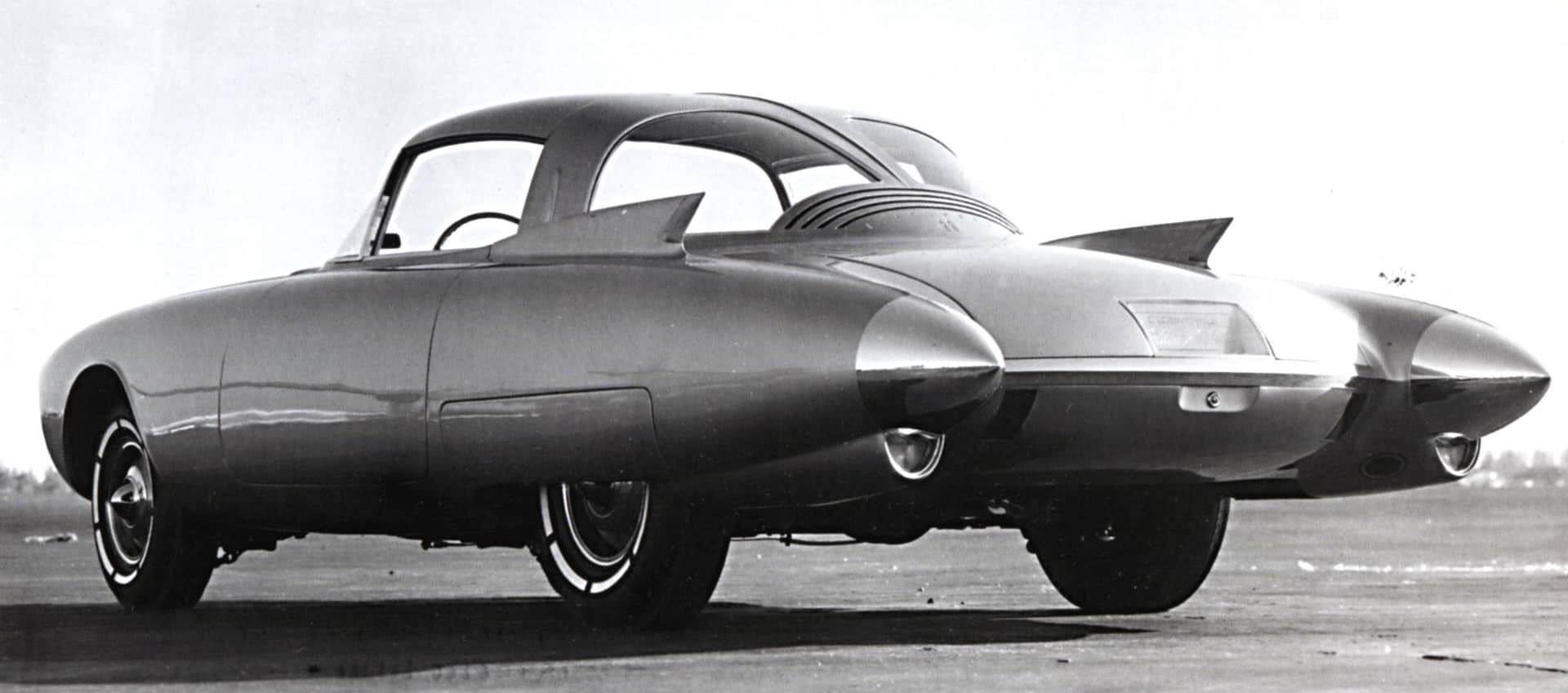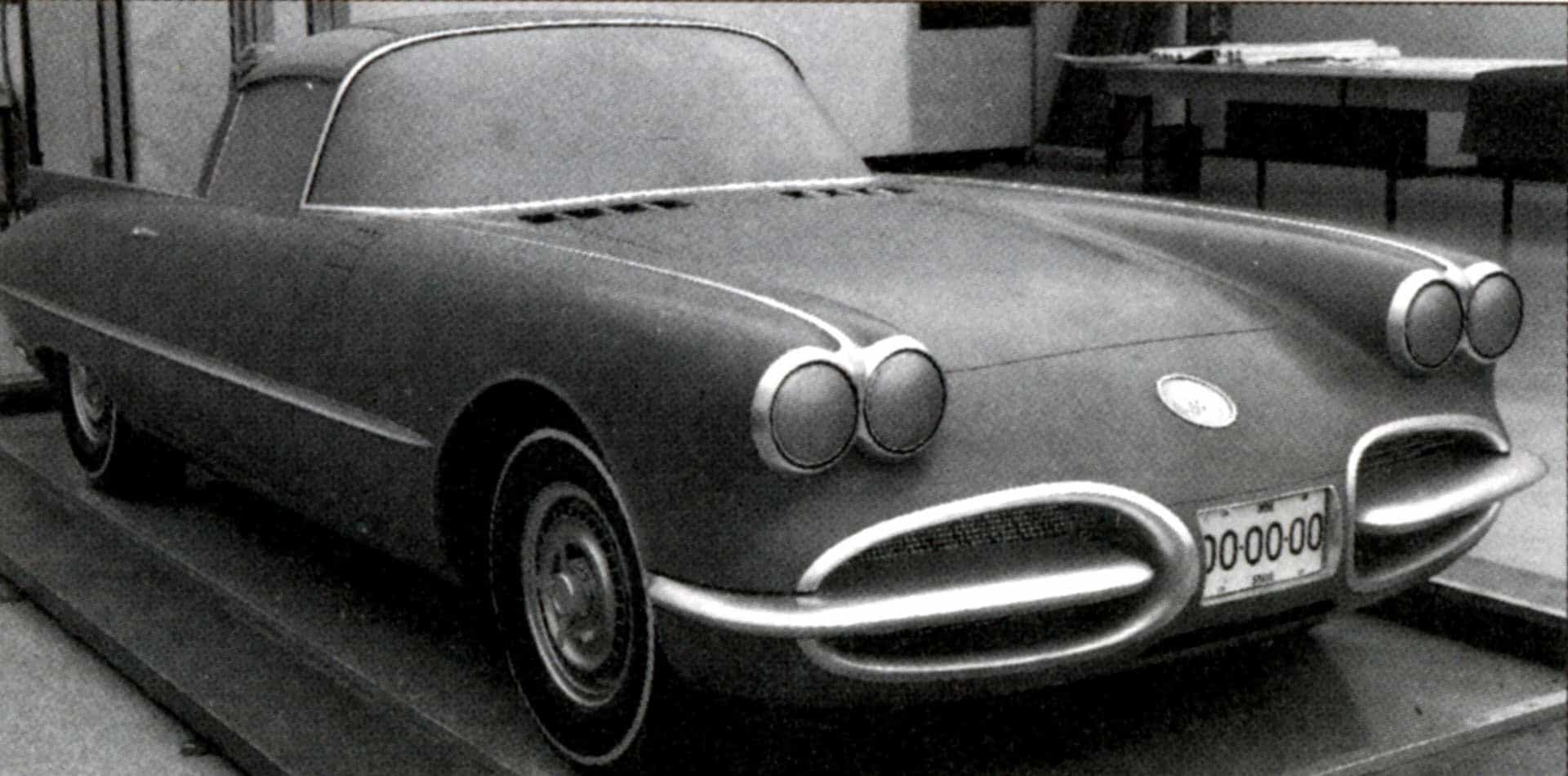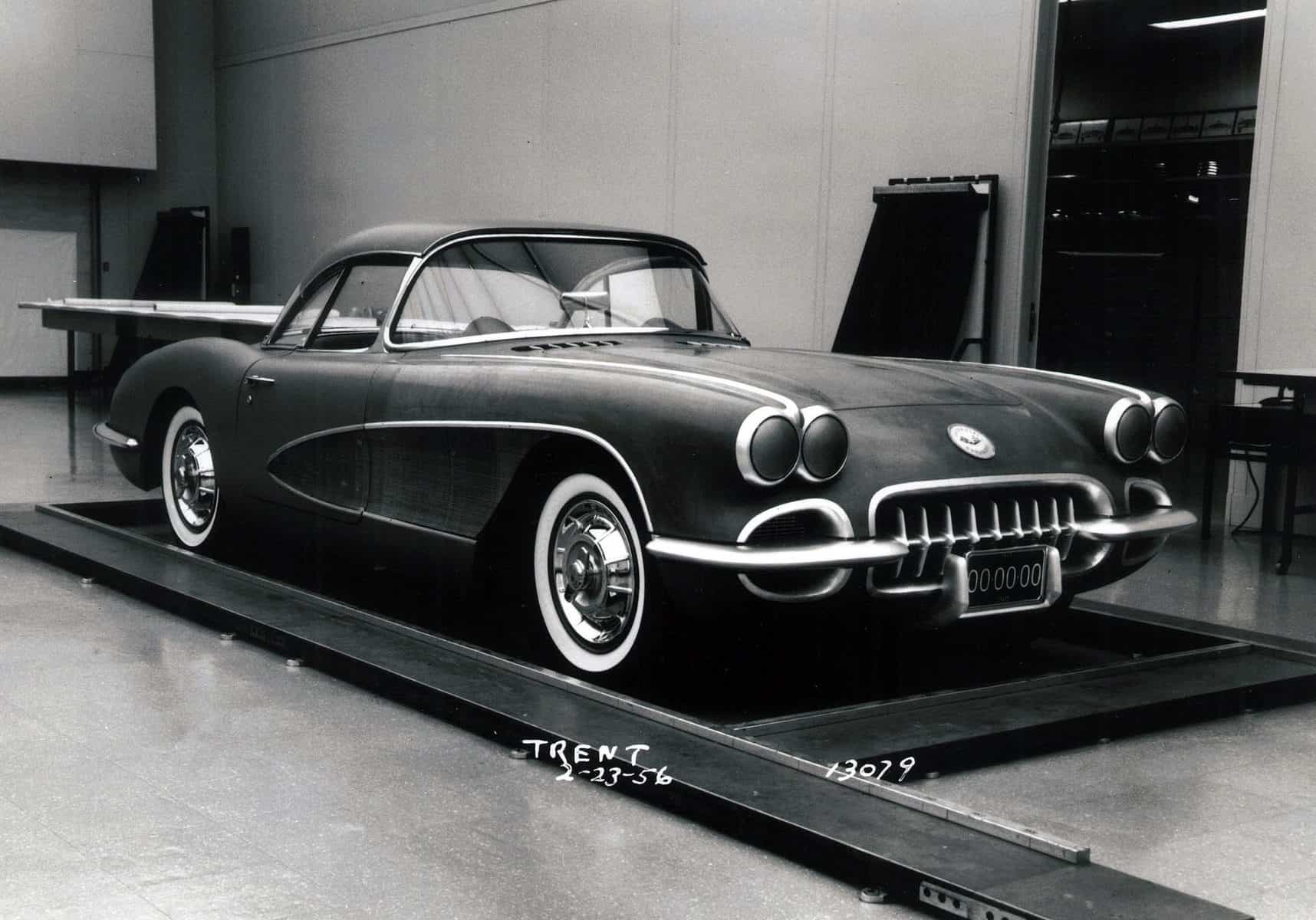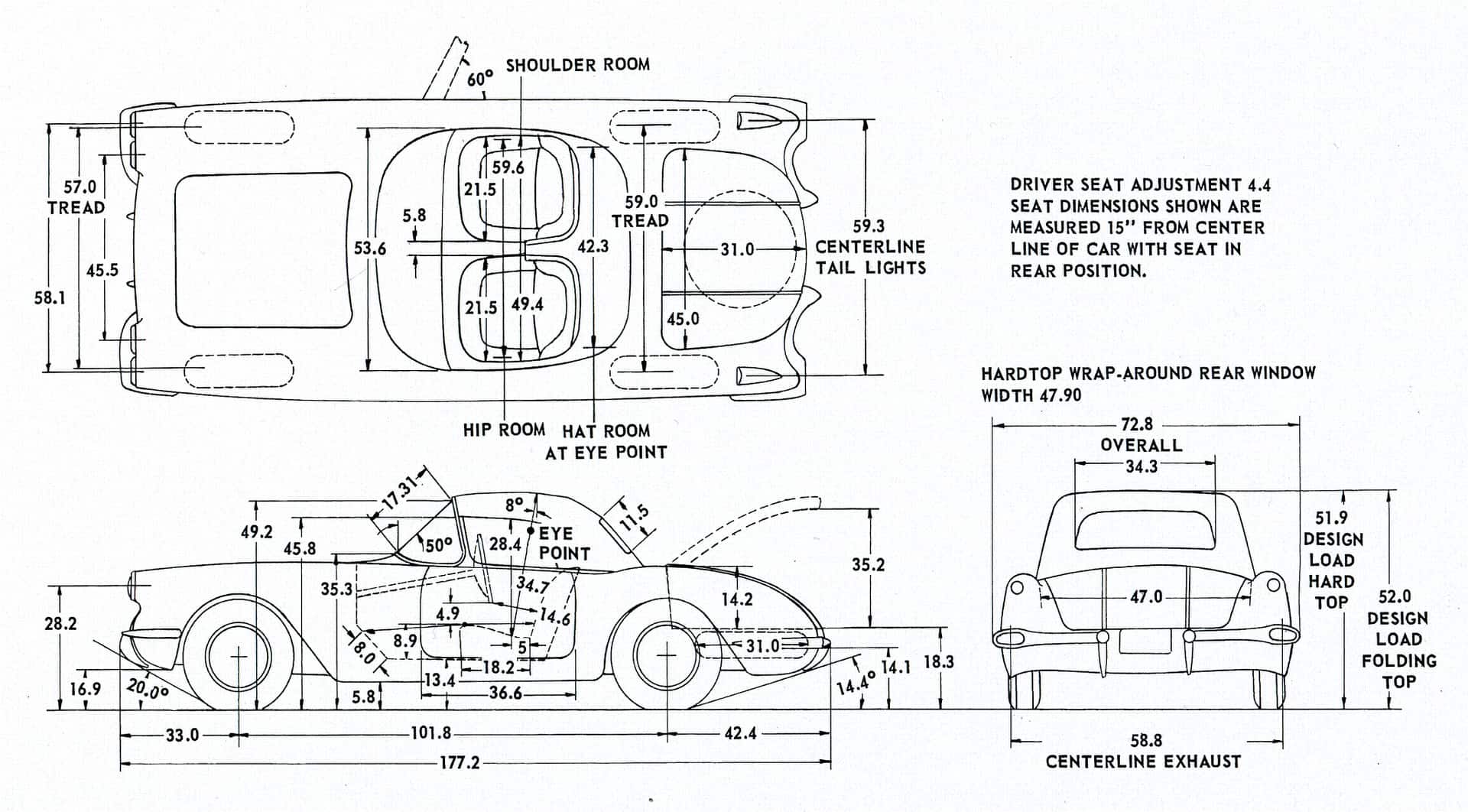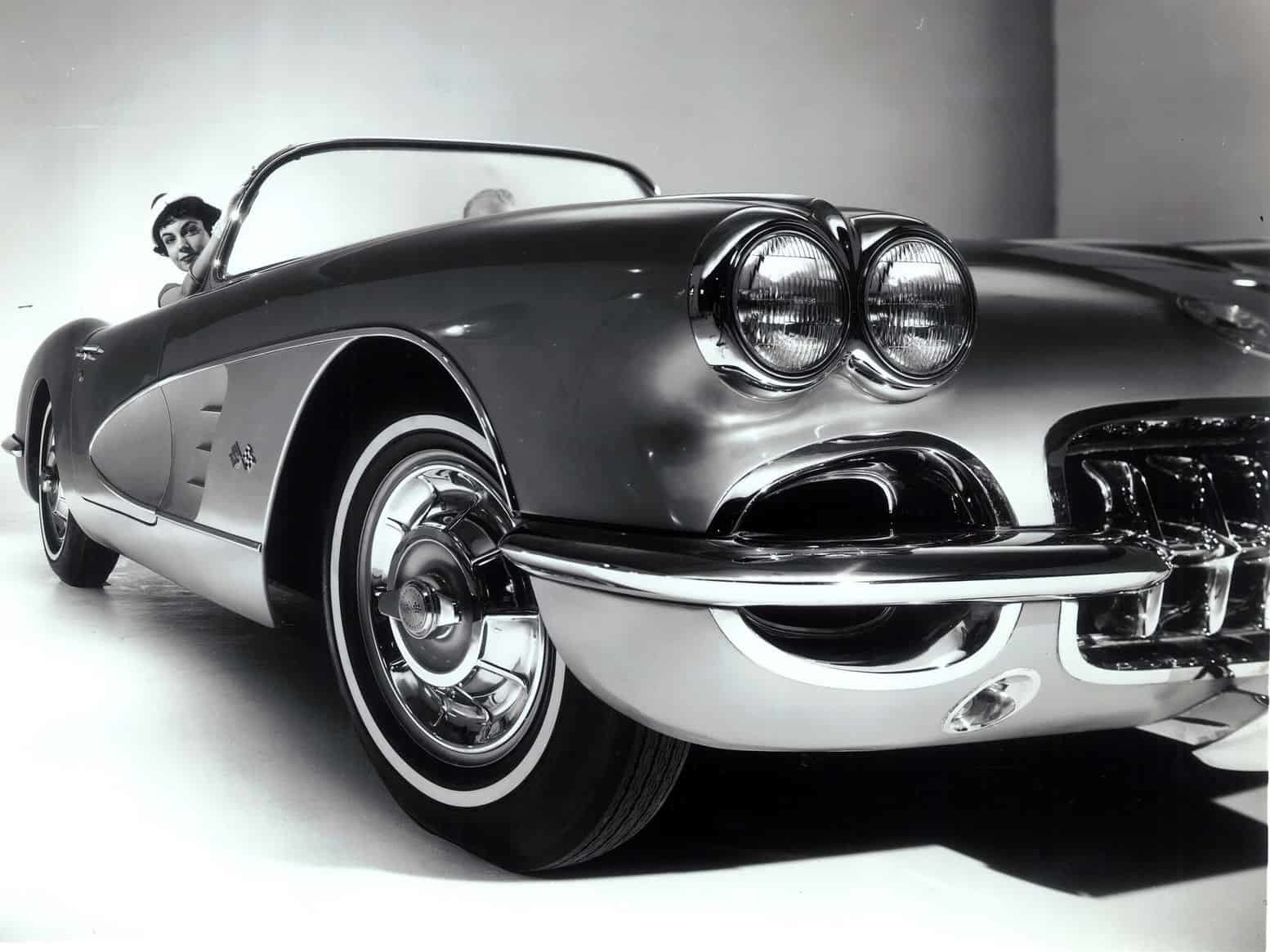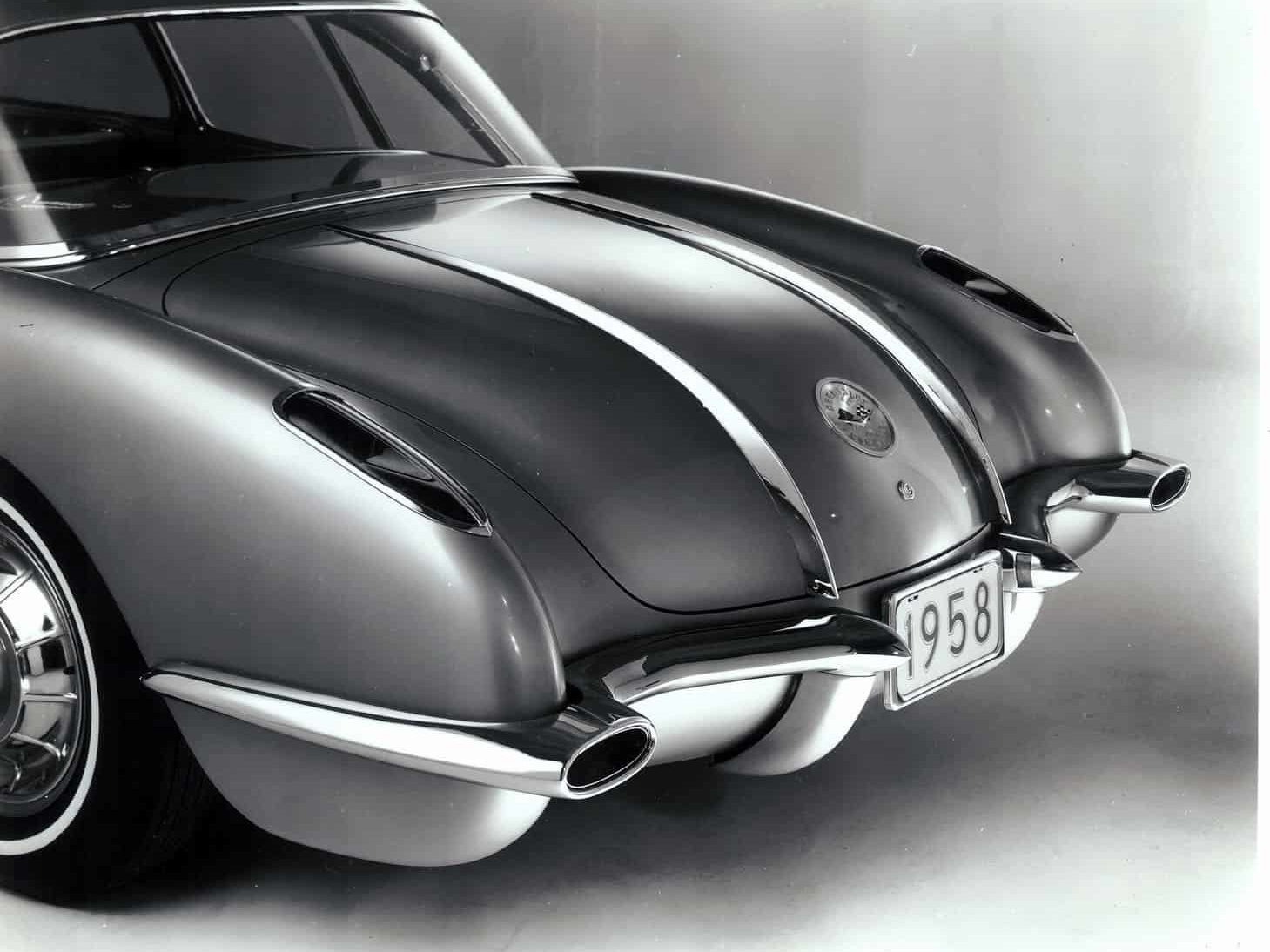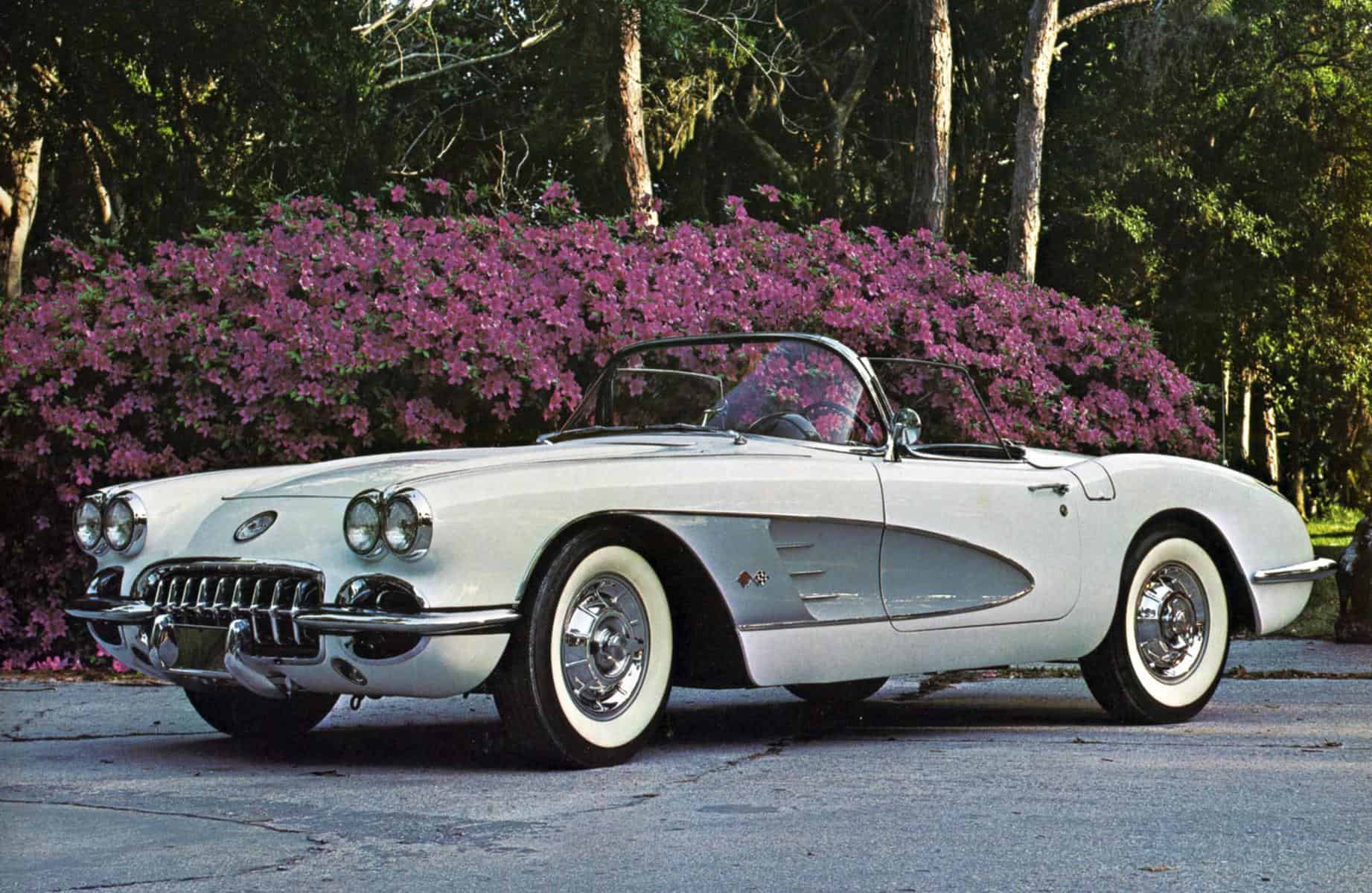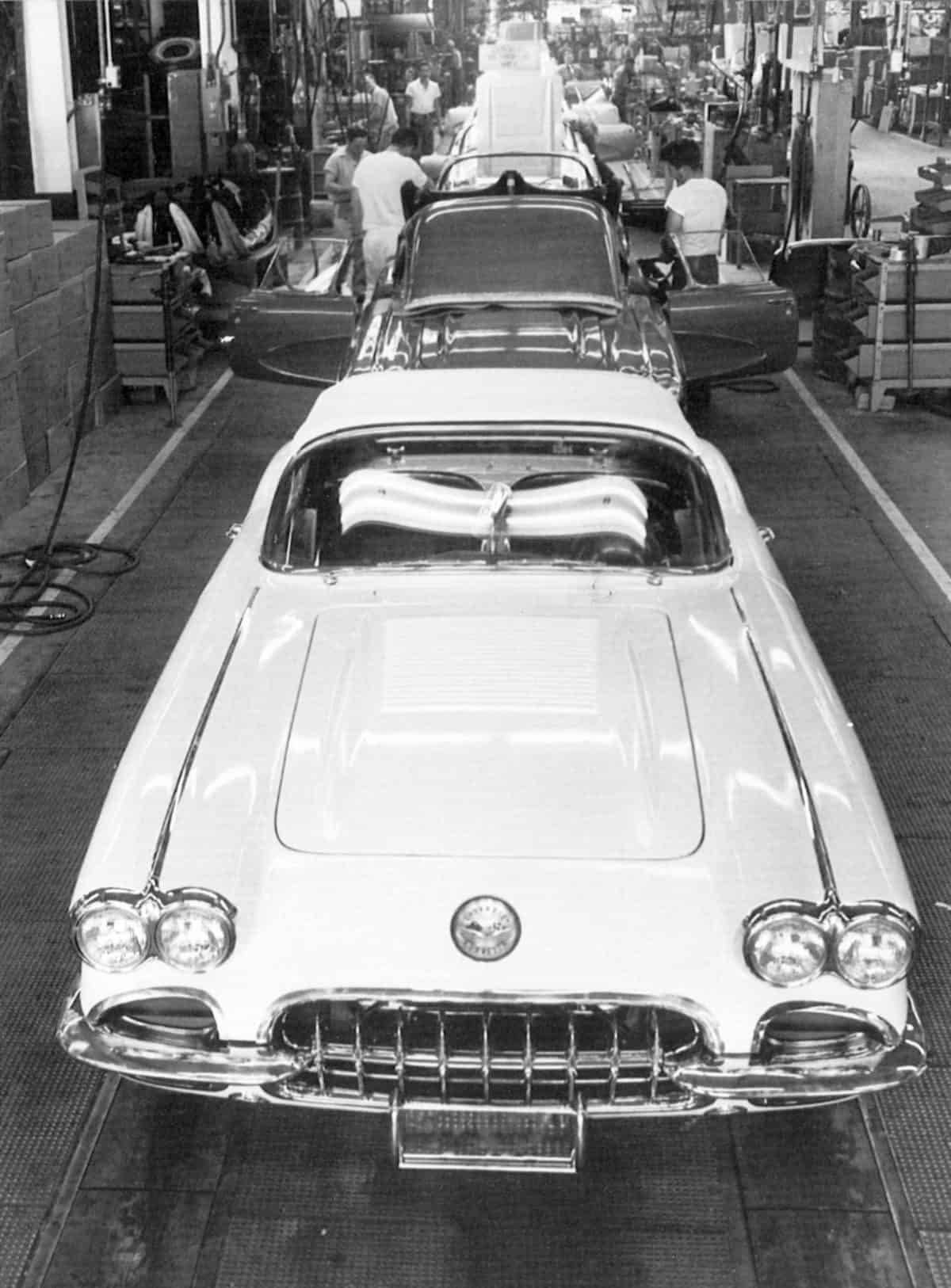Corvette Goes All-American
How Chevrolet and GM Styling pulled out all the stops for 1958
BY: KARL LUDVIGSEN
PHOTOS: GM HISTORICAL ARCHIVE & LUDVIGSEN PARTNERS
Stylists, engineers, marketers, dealers, and advertising experts all have their say in the creation of a new car model. Top executives of the auto companies also have much to contribute to car design, even when they’re not highly qualified to do so.
As one frustrated industry underling complained, “That’s really all the fun those guys have in this business!” And where there’s indecision there’s more room for conflicting opinions. There was to be a future for the Corvette. That bridge was crossed in 1955. But no one was quite sure what that future was beyond 1957.
Styling Staff, which had taken the lead in the Corvette’s original creation, did so again in the planning of a totally new car for 1958. During the autumn of 1955 a new dream car, the Golden Rocket, was designed and built for display by Oldsmobile in the 1956 Motorama. It had a sheer, grille-less front end, fender pontoons of virtually tubular section, and a tapering fast-back coupé canopy flanked by vestigial fins. Entry headroom was added by a flap above each side window that lifted automatically when the door was opened.
The Golden Rocket project inspired virtually concurrent design work on a new Corvette. GM’s designers conceived this new Corvette solely as a coupe, no roadster version to be offered. This made it easier to engineer the car with unit construction, replacing a separate frame, while making extensive use of aluminum body and structural panels.
Design work on this new car started in September 1955 with Robert Cumberford among those involved. The clay model completed in midwinter kept the general lines and proportions of the Golden Arrow but had a completely different front end, with four headlamps—the rage then sweeping the industry, led by GM—above two large oval nostrils as air inlets.
In March of 1956 a fiberglass styling model of this proposed new 1958 Corvette was completed. Much more engineering work remained to be done, however, before such a radically changed car could be readied for production. A crisis in the manufacturing development of a new Chevy truck range drew away the needed engineers, as did the heavy workload demanded by the all-new 1958 Chevrolet production car. Corvette as Son of Golden Rocket was shelved for 1958 and, as it turned out, for good.
Styling began early in 1956 on a heavy facelift of the existing Corvette as a backup to the all-new car. Carried out in the normal Chevrolet Studio under Clare MacKichan, work led by Chuck Jordan was aimed at giving Chevy’s sports car more glitter and gloss to exploit the superficial appeal that was felt, at that time, to have so much to do with the successful selling of cars. As one writer remarked, this was 1956 “when insolence still sold chariots.” This trend reached its apogee—or nadir—in 1958 when all GM’s cars were the most heavily bedecked with chrome and ornament in the company’s history.
Four headlamps were faired into the fenders and surrounded by a chrome bezel from which a chrome strip trailed back atop each fender. The two big nostrils that had been the sole air inlets of the originally planned new car became smaller inlets flanking the main opening, keeping the Corvette’s characteristic oval grille. All three openings had heavy chrome surrounds. Simple grille patterns were tried, honeycomb designs and fine mesh, but in the final design the familiar “teeth” again featured in the central grille.
These main changes were envisioned until the spring of 1956, when the car’s quota of non-functional styling features suddenly skyrocketed. Washboard-like ridges appeared atop the hood in simulation of air-outlet louvers. “The 1958 Corvette hood was originally designed with the louvers open to aid in cooling the engine,” Zora Arkus-Duntov explained. “Mr. MacKichan said that this would solve our problem. But the louvers were behind the oil breather and at speed it would throw oil on the windshield. MacKichan said it was too late, we were locked into the design. The answer: close them.”
Dummy air outlets sprouted in the fender coves, behind the front wheels. Two air scoops beside the main grille were dummies on production Corvettes. The rear deck sprouted twin chrome strakes like those used on an earlier one-off car for Sweden’s Prince Bertil.
The new look marked the end of the Corvette’s “shy guy” origins. While the 1953 design had a distinct American character with its wraparound windscreen and shapely tail, its facelift had taken it in a mainly European direction. For the purists this was an improvement, but the Corvette was an American car first and foremost.
The 1958 design transformed Chevy’s sports car with an assertive style that shouted, “Gangway, I’m coming through!” Over-egged though they were, its many decorative touches enhanced buyers’ perceptions of the Corvette’s value. And the car had the performance to make good on its ebullient looks.
Its new body increased length from 168.0 to 177.2 inches, mainly at the front, and width from 70.5 to 72.8 inches. Instead of being attached to the body as they’d been before, more-substantial bumpers were now braced directly to the frame by long steel brackets. Inside the body, the cowl supports of aluminum that were added during 1957 were supplemented in the ’58 model by metallic backing along the rocker panels, below the doors.
The GRP body material had been steadily improved and was now stabilized in design. Final changes in its specification were made on April 21, 1957. All the body improvements added to the Corvette’s weight, which in a fully equipped 1958 car was over 3,000 pounds for the first time, some 200 pounds more than the 2,880-pound ’57 model.
So extensively reworked was the new Corvette’s interior that the only familiar items remaining were the steering wheel, shift lever, and the white pull-knobs that opened the doors. Instruments were all grouped in front of the driver, dominated by a huge 160-mph speedometer. At its base, above the steering column, was the 6,000-rpm tachometer. Flanking it were the other four dials, all in deeply recessed cowlings.
Clock, radio, and heater controls were carried by a central console, making the Corvette one of the first American cars to put this console motif, so often projected by dream cars, into production. Facing the passenger was a grab handle across an otherwise function-free recess.
Improvements in the Corvette’s instrumentation were owed in large measure to Zora Arkus-Duntov’s increased official involvement with the Corvette. “In 1955,” Zora recalled, “Harley Earl invited me to Styling, assembled his entourage, and said, ‘Let’s do the car like this man says.’ The 1953 Corvette had a tachometer at the center of the dash. I said, ‘There’s no way that you can monitor that.’ Subsequently it was mounted above the steering column. It was not a very good location but at least it was in the field of view.” Seat belts became standard equipment in the 1958 model.
Hard-won high-speed experience at Daytona and Sebring showed up under the hood of the ‘58 Corvette. Now all models had the generator mounted on the right-hand side so the fan belt wrapped more fully around the water pump/fan pulley. The heavy-duty chassis option was carried over from 1957, including built-in ducts that carried cooling air from the two front nostrils and through the rocker panels to the rear brakes.
Better fuel metering resulted from redesign of the injection nozzles. A more sensitive diaphragm controlled the mixture during warm-up. A new paper-element air cleaner was fed cool air by a front-end duct when the injection was married with the Duntov camshaft in RPO 579D. Peak injected output was now quoted as 290 hp at 6,200 rpm for the 283-cubic-inch V-8. This engine came with a mechanically driven tachometer reading to 8,000 rpm. A new combination for 1958 was RPO 469C, mating the high-rev Duntov cam with two four-barrel carburetors. It was rated at 270 hp at 6,000 rpm.
Motor Trend scored a coup by cadging four 1958 Corvettes of 230, 245, 250, and 290 horsepower from dealers to be tested by retired racing driver Sam Hanks, 1957 Indianapolis 500 winner. “I objected to the wheel position,” said Hanks. “It’s too straight and close to the driver. You don’t get any leverage this way for fast cornering. It’s like throwing close-in uppercuts instead of long-range jabs where you can get the weight of your body behind them. They could cut down the size a bit too, so your hand could clear the door-release knob when you’re steering.
“You’ve got lots of power and good handling characteristics with all the Corvettes I drove,” added Hanks, who wrung them all out at Riverside. “I think my choice for an everyday job would be either the 250 with fuel injection or 230 with single quad carb and three-speed box. I’d also choose the hardtop model because vision is better. When the soft top is up there’s a blank spot over on the right hind quarter.” The MT crew measured a best 0-60 mph time of 6.9 seconds with the 290 hp Corvette, which reached 118.7 mph at the end of a 15.6-second quarter-mile.
Although it graced the cover of its December 1957 issue with a photo of the 1958 Corvette, Road & Track took a shot at its new design. Blaming “the corrosive influence of the ‘stylists,’” it judged that “the new model had grown too fussy. That supposedly hard-to-sell commodity, elegant simplicity, has gone.” In the interior, R&T remarked, “the first mass-production use of a central ‘control tower’ is here haltingly pioneered. No true car controls are mounted in this spot, which has the advantage of their not being reachable, on purpose or accidentally, by a passenger.”
Racing driver Ken Miles drew attention to seats that he considered poorly designed: “In only two respects does the car fall short. While the styling department is undoubtedly responsible for the miserably illegible instruments, I feel that the engineering department is probably to blame for the totally inadequate seats which are neither comfortable to ride in nor give any lateral support at all so there is a constant temptation to drive round corners hanging on to the door with one hand in order to stay behind the wheel.”
This was no surprise to Zora Duntov, who gave the seats a priority when it came to planning the 1959 model. Zora’s special status with regard to the Corvette was made official by a Chevrolet Engineering memo in August 1957. Corvette changes for 1959 were constrained by the demands on engineers and stylists made by the crash program staged by GM to bring out new body styles across the board to meet the challenge of Virgil Exner’s “Forward Look” for Chrysler.
In addition to improving the seats, Duntov also moved the inner door-opening knobs farther forward on the 1959 Corvette. Driving an earlier model on a rainy day, he’d noticed that the strap on the sleeve of his raincoat tended to snag on the knob and open the door when he made a left turn. On the passenger’s side of the dash an open stowage bin below the grab handle was a welcome addition.
The 1959 Corvette was the first to have a T-handle on the gear-shift knob to serve as a positive lockout for reverse gear. Clutch linkage was made more easily adjustable in the shop to give either a 6.5-inch travel with low effort or a more responsive 4.5-inch travel with higher resistance.
As Road & Track remarked, “The appearance of the 1959 Corvette has been improved by the simple expedient of removing the phony hood louvers and the two useless chrome bars from the deck lid.” The wheel disc was also changed for the first time since 1956, acquiring ten small rectangular slots around its periphery to permit cooling air to flow through them and matching vents in the steel wheels.
New in ’59 was option RPO 686, to give better braking in hard over-the-road driving. It used sintered-metallic linings developed by GM’s Delco Moraine Division. Each brake had three pairs of lining segments riveted to the primary brake shoe and five pairs of segments, slightly thicker, riveted to the secondary shoe.
Special brake drums had no fins but were flared at their open end to prevent bell-mouthing and honed to an inner surface finish as smooth as that of the cylinder bore of an engine. These linings were less harsh on the drums than the ceramic-metallic type, far less sensitive when they were cold, and cost a mere $26.90 if they were ordered with the car.
Major additions to the rear suspension of the 1959 model were trailing radius rods from the frame to attachment points above the axle at each side. Working in tension to oppose the axle’s torque reactions, these helped suppress the rear-axle chatter under acceleration from low speeds that had been an obvious fault ever since power had been stepped up in the ’57 model.
The presence of these rods allowed the lower mounts of the rear shock absorbers to be relocated so they experienced longer travel with wheel movement, giving better damping. Fluid foaming in the shocks was discouraged by the insertion of a nitrogen-filled bag to fill volume that otherwise attracted air that formed bubbles and impaired the damper’s efficiency.
All the goodies it was possible to buy on a Corvette were gradually elevating its price. Base figure in 1959 was $3,875.00. With desirable options like the 290 hp engine ($484.20), station-seeking radio ($149.80), heater ($102.25), hardtop ($236.75), as well as folding top and four-speed manual transmission, the car tested in 1959 by Sports Cars Illustrated priced out at $5,127.80, not including taxes and transportation.
Costly though it was becoming, the ’59 Corvette certainly performed. It accelerated to sixty in 6.6 seconds with the 4.11 axle, to eighty in 10.1, and to one hundred in 15.6 seconds. It reached 98 mph in the standing quarter-mile and covered it in 14.9 seconds. Acceleration from rest to 100 and braking to a stop took 26.4 seconds. It accelerated from rest to 100 and braked to a stop again in 26.4 seconds, “a figure that could be improved upon with experience,” said SCI tester Stephen Wilder.
“That one Corvette is not the same as another,” Wilder added, “is evident from the variety of options. What comes as a considerable surprise is the dualistic personality of the car tested. In the twinkling of a throttle linkage it turns from a submissive sidewalk stalker to a fierce, roaring eater-upper of metallic monsters. Just as quickly it reverts to silent smoothness, its exhaust murmuring, barely audibly, ‘Who, me?’”
There’d been high hopes for heavy fallout from the T-Bird market, with its two-seater no longer available, in favor of the much-changed 1958 Corvette. A production schedule of 11,000 units was set, nearly doubling the 1957 level. Reality fell short of that, with 9,168 ’58 models being built, but that was enough of a jump in relation to the modest cost of retooling the new body to allow Chevy to make money on the Corvette for the first time.
Sales of the facelifted car steadied while production continued its gradual climb toward the level originally visualized for the St. Louis plant. It reached 9,670 for the 1959 model. This was a big improvement from 6,339 in 1957. In spite of its split personality—underneath Bill Mitchell’s baroque styling the chassis artistry of Zora Duntov—or perhaps because of it, the maturing Corvette was becoming quite a car.
